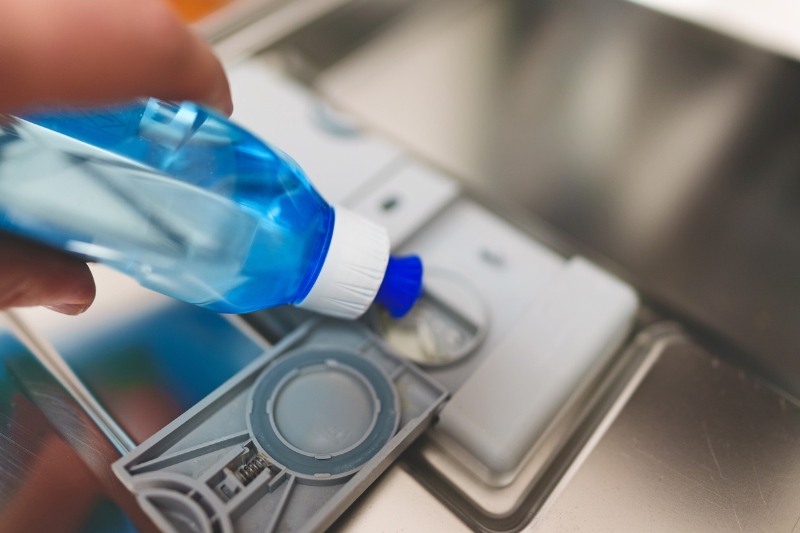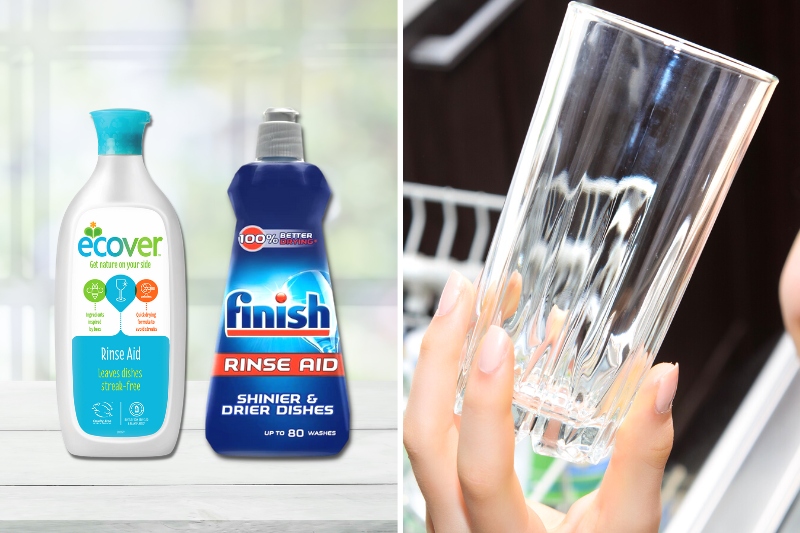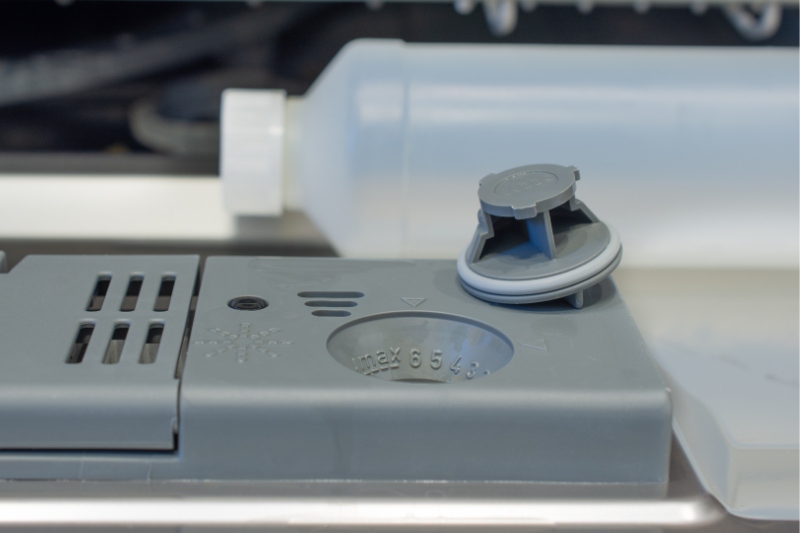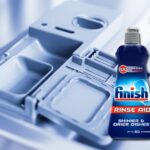Have you ever wondered why manufacturers tell you to use rinse aid in your dishwasher? Of course, we all know why you need to add detergent when washing a load of dishes, but most of us are in the dark when it comes to rinse aid!
While some people swear by using this product, others see it as an unnecessary expense. In fact, many have gone years without using it and have yet to notice any difference in the appearance of their dishes.
So, what does rinse aid do in a dishwasher? Do you really need to use it? And is there an alternative you can use instead? Read on to find out!
What Does Rinse Aid Do?

Dishwasher rinse aid is a surfactant (surface active agent), meaning it contains chemicals that lower the surface tension of water.
Although this sounds complicated, it essentially means that the water in your dishwasher is more likely to spread out rather than form droplets on the surface of your dishes.
As the water can slide off your kitchenware more easily, you are less likely to find water spots or streaks left behind after your dishwasher cycle has finished when using rise aid.
It also helps speed up the drying process, saving you the hassle of drying your dishes before you can put them away.
Do I Really Need to Use Rinse Aid?

Since 2017, the use of rinse aid has slowly been increasing in the UK. This is because a change to UK legislation meant that dishwasher detergents could no longer contain high levels of phosphates. The subsequent changes to these detergent formulas mean that streaking is much more likely.
This being said, if you are already getting the results you want from your dishwasher without the use of a rinse aid, it is not essential that you use it.
However, those of you that live in hard water areas will typically benefit from this product, as water spots and streaking are more likely to occur when there are high proportions of minerals in your water supply.
There are some dishwasher detergents on the market that come with rinse aid built in. Unfortunately, these all-in-one tablets will not be as effective as using a separate rinse aid product. Still, they can make a significant difference to the cleanliness of your dishes, especially if you have soft water.
How Do I Know If My Dishwasher Needs Rinse Aid?

Unlike dishwasher detergents, rinse aid does not need to be added to your dishwasher at the start of every cycle.
Instead, your dishwasher will have a small light on its control panel that will light up when the rinse aid compartment needs to be refilled.
This compartment is found on the inside of a dishwasher door, next to the detergent dispenser. To refill the compartment, you need to follow the below steps:
- Open the rinse aid compartment by pressing on the latch and lifting the lid.
- Pour your rinse aid into the dispenser until it is full to the max line.
- Press down on the lid until it clicks shut.
- Wipe any excess rinse aid from around the compartment.
The frequency at which you will need to do this depends on how regularly you use your dishwasher and how much rinse aid your dishwasher is set to release during a cycle.
Each dishwasher will come pre-programmed to dispense a certain amount of rinse aid. This setting can be manually adjusted by moving the dial found the lid of the rinse aid compartment.
Usually, the pre-programmed setting will give you the clean and streak-free results you need.
However, we suggest increasing the amount of rinse aid dispensed if your dishes regularly come out with water spots on them.
You can also reduce the amount of rinse aid used if you notice rainbow streaks on your kitchenware, as this suggests too much is being dispensed.
What Can I Use Instead of Rinse Aid?

Store-bought rinse aid products contain a lot of harsh chemicals. If you would prefer to use a more natural alternative, there are some other products you can use to get that streak-free shine:
- White vinegar: White vinegar will remove mineral residue from your dishes and help keep your dishwasher clean at the same time. You can fill the dispenser as usual or place a small bowl full of vinegar in the bottom rack. We suggest using vinegar with less than 5% acetic acid, as a higher acidity may damage your appliance’s rubber seals and gasket.
- Hydrogen peroxide: Hydrogen peroxide is a non-toxic bleach alternative that is regularly used in homemade cleaning products and effectively cuts through mineral deposits. You can fill the rinse aid dispenser with this solution and use your dishwasher as you typically would.
- Lemon or Lime: Lemons and limes both contain citric acid, a natural chemical that helps break down any deposits on the surface of your dishes. To use them as rinse aid, you can either place half of a lemon or lime on the top rack of your dishwasher during a cycle, or you can fill the rinse aid compartment with the juice.
- Citric acid: While citric acid is found in lemons and limes, it can also be purchased in liquid or crystal form for use in cleaning. If you get the crystals, mix them with a little boiling water to create a liquid. The citric acid can then be poured into the dispenser like normal.
Before using any of these alternatives, it is worth checking with your dishwasher manufacturer that your warranty won’t be invalidated if you add them to your rinse aid compartment.
If you are uncertain, there are some more eco-friendly rinse aid products that contain fewer chemicals that you could try instead. For example, Ecover produces a plant-based rinse aid that consistently gets good reviews.

Hannah has a passion for cleaning. She worked her way around Australia by cleaning hostels in exchange for free accommodation and used her cleaning skills to bag a job as a chalet host for a luxury ski company in France.






